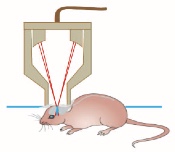Mar 19, 2015
Ultrasound treats Alzheimer’s disease, restoring memory in mice

Scanning ultrasound treatment of Alzheimer’s disease in mouse model (credit: Gerhard Leinenga and Jürgen Götz/Science Translational Medicine)
University of Queensland researchers have discovered that non-invasive scanning ultrasound (SUS) technology* can be used to treat Alzheimer’s disease in mice and restore memory by breaking apart the neurotoxic Amyloid-β (Aβ) peptide plaques that result in memory loss and cognitive decline.
The method can temporarily open the blood-brain barrier (BBB), activating microglial cells that digest and remove the amyloid plaques that destroy brain synapses.
Treated AD mice displayed improved performance on three memory tasks: the Y-maze, the novel object recognition test, and the active place avoidance task.
The next step is to scale the research in higher animal models ahead of human clinical trials, which are at least two years away. In their paper in the journal Science Translational Medicine, the researchers note possible hurdles. For example, the human brain is much larger, and it’s also thicker than that of a mouse, which may require stronger energy that could cause tissue damage. And it will be necessary to avoid excessive immune activation.
The researchers also plan to see whether this method clears toxic protein aggregates in other neurodegenerative diseases and restores executive functions, including decision-making and motor control. It could also be used as a vehicle for drug or gene delivery, since the BBB remains the major obstacle for the uptake by brain tissue of therapeutic agents.
Previous research in treating Alzheimer’s with ultrasound used magnetic resonance imaging (MRI) to focus the ultrasonic energy to open the BBB for more effective delivery of drugs to the brain.
23:27 Posted in Neurotechnology & neuroinformatics | Permalink | Comments (0)







The comments are closed.